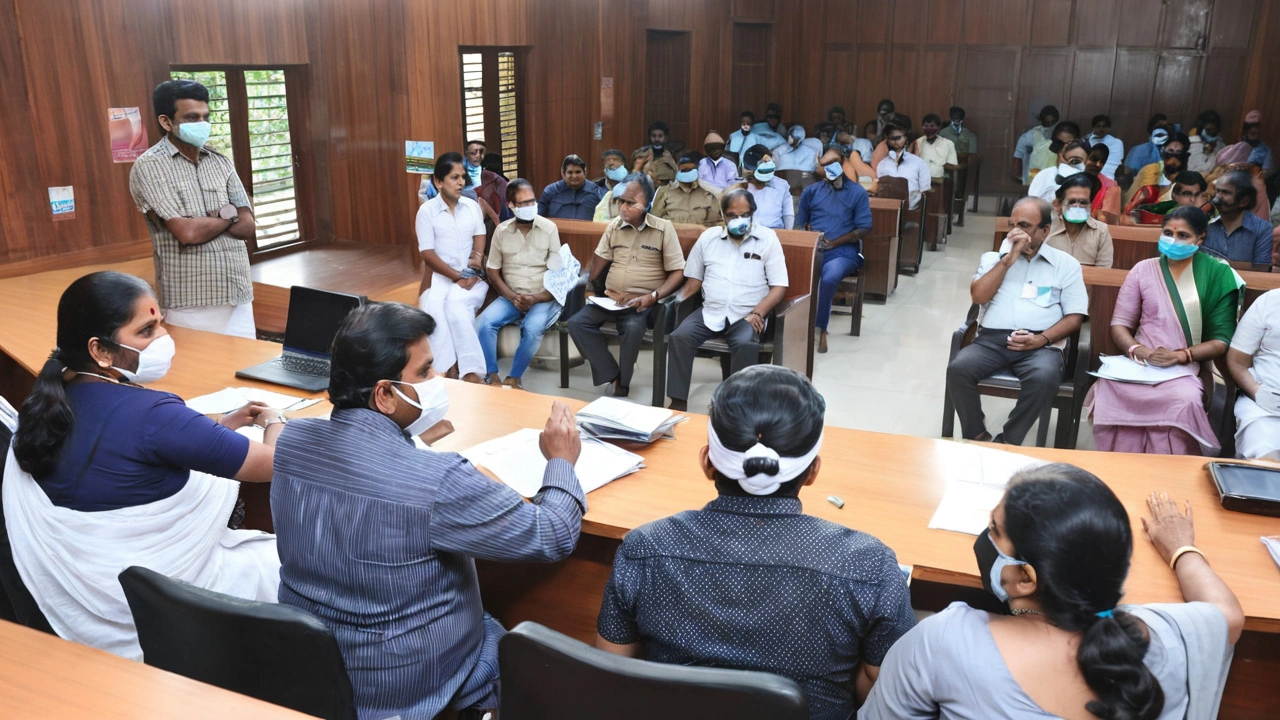Tragic Death of a Teen Raises Alarm in Kerala
The usually serene neighbourhood of Malappuram in Kerala was plunged into sorrow and concern as a 14-year-old boy succumbed to the deadly Nipah virus. The tragic event has sent ripples through the community and has reignited the fear of the virus that has haunted the region in previous years. This fatal incident is not an isolated case but a stark reminder of the ongoing battle against the Nipah virus, which has had a recurring presence in Kerala since 2018.
Fruit Bats: The Suspected Source of Infection
The young boy's encounter with the Nipah virus is believed to have started with a simple act of consuming a local fruit. The boy had eaten hog plum fruit, locally known as ambazhanga, from his own neighbourhood. Several days following the consumption, he developed a high fever. Unfortunately, the fever turned out to be a symptom of a much graver issue. Health Minister Veena George addressed the public, confirming that the presence of fruit bats in the area strongly suggests that the fruit the boy ate was contaminated by the bats. This association is not new; fruit bats have been identified repeatedly as the primary vectors for Nipah virus transmission.
Investigations and Scientific Endeavors
Immediate steps have been taken to investigate the extent and source of the infection. A team from the National Virology Institute in Pune has been dispatched to examine the fruit bats in the infected region. Their goal is to conduct a rigorous analysis to confirm the presence of the virus in the bats. Understanding the exact pathway of transmission can help form effective countermeasures to prevent further spread of the virus.
A Historical Perspective
This incident is a harsh reminder of the previous Nipah outbreaks in Kerala. The state faced significant challenges during the outbreaks in 2018, 2019, 2021, and most recently, in 2023. Each time, the health authorities identified a link between fruit bats and the eruptions of the virus. The recurring pattern highlights the need for a comprehensive and sustained public health strategy to address this ongoing threat.
Measures to Contain the Outbreak
The health department has quickly sprung into action to contain the potential spread of the virus. A control room has been set up in Malappuram, with medical professionals and emergency responders on standby. Public health advisories have been issued, urging residents to wear masks and maintain hygiene to minimize the risk of infection. Crucially, the community has been advised to avoid consuming fruits that might have been exposed to wildlife, especially those from areas known to be habitats for fruit bats.
Public Response and Awareness
The local community in Malappuram is understandably anxious, yet there is also a growing awareness about the Nipah virus. Information campaigns are being accelerated to educate people about the symptoms, preventive measures, and the importance of reporting any suspected cases instantly. Schools and local organizations are playing their part by disseminating information and ensuring that children and their families are well-informed about the risks.
Challenges Ahead
Despite the swift response, the incident underscores the vulnerabilities in our current public health frameworks. There is a pressing need for more robust surveillance systems and targeted research to understand how zoonotic diseases like Nipah virus jump from animals to humans. Strengthening local public health infrastructure, fostering community engagement, and encouraging collaborative efforts between national and international health bodies will be vital in combating these outbreaks.
A Call for Comprehensive Strategy
The continuous recurrence of Nipah virus outbreaks highlights a critical need for an integrated approach. There should be a combination of scientific research, community health initiatives, and governmental policies designed to address both immediate and long-term challenges posed by the virus. Collaboration with international health organizations could also provide valuable insights and resources for managing the outbreaks more effectively.

Conclusion
The death of the 14-year-old boy in Kerala is a somber reminder of the ever-present dangers posed by zoonotic diseases. As the community grieves and scientists work tirelessly to uncover the details of the virus transmission, the incident should galvanize stakeholders at every level to prepare, prevent, and eventually eradicate such threats. The lessons from past outbreaks must inform future actions, ensuring that the tragic loss of life leads to stronger, more resilient public health systems.

8 Comments
Mayur Karanjkar July 22 2024
The epidemiological correlation between Pteropus fruit bats and zoonotic Nipah spillover underscores the necessity for robust sentinel surveillance and phylogenetic mapping of viral reservoirs.
Mitigating anthropogenic encroachment into bat habitats could attenuate arboreal transmission vectors.
Sara Khan M July 27 2024
Another tragedy, same old story 😒
shubham ingale August 1 2024
Stay safe folks! Wash hands, wear masks, avoid wild fruit 🍎
Ajay Ram August 6 2024
The recent loss of a teenage life in Malappuram starkly reminds us of the fragile interface between human settlements and wildlife ecosystems.
Nipah virus, an RNA paramyxovirus, has repeatedly exploited this interface via fruit bat reservoirs, especially Pteropus species.
While the immediate cause appears to be consumption of contaminated ambazhanga, the deeper driver is habitat fragmentation that forces bats into closer proximity with humans.
Public health officials rightly emphasized mask usage and hygiene, yet these measures address only the downstream effects.
Proactive strategies must include ecological stewardship, such as preserving bat roosting sites away from orchards.
Community education programs, tailored in Malayalam and other local dialects, can empower residents to recognize high‑risk behaviors.
Moreover, rapid diagnostic capacity at district hospitals is essential to isolate cases before they seed secondary transmission chains.
The deployment of the National Virology Institute team to sample local bat populations is a prudent step toward molecular surveillance.
Sequencing data from these samples can reveal viral clades and inform vaccine target selection.
In parallel, we should explore the feasibility of a One Health framework that integrates veterinary, environmental, and medical expertise.
Such interdisciplinary collaboration can identify early warning signals before human cases emerge.
Governmental policy must also allocate funding for continuous bat monitoring rather than episodic responses triggered by outbreaks.
International partners, including WHO and CDC, can provide technical assistance and share best practices from similar zoonotic events worldwide.
Ultimately, resilience against Nipah hinges on a societal shift that respects ecological boundaries while safeguarding public health.
Let the memory of this young boy galvanize collective action, lest we repeat this tragedy in the years to come.
Dr Nimit Shah August 11 2024
While the philosophical perspective is valuable, the reality is that complacency fuels repeat outbreaks. Your call for systemic change is spot‑on, but without immediate community compliance the virus will find a foothold again. Let's push for concrete actions now.
Ketan Shah August 15 2024
The situation underscores the necessity of integrating epidemiological data with local cultural practices. Engaging village elders to disseminate accurate information can bridge the trust gap often seen in rural health initiatives. Additionally, mapping bat migration patterns alongside fruit harvest calendars may reveal critical overlap periods. Investing in portable PCR units for district labs would dramatically reduce diagnostic turnaround times. Such measures, combined with sustained public outreach, could transform reactive responses into preventive stewardship.
Aryan Pawar August 20 2024
We need to act fast no time to waste the community must stay alert and follow guidelines together we can stop spread
Shritam Mohanty August 25 2024
The official narrative conveniently downplays potential lab involvement and the role of foreign biotech firms in altering viral genomes. Hidden agendas within the health ministry may be steering resources away from genuine ecological surveillance. Citizens deserve transparency about how samples are processed and who funds the research. Until the truth surfaces, trust in these institutions remains eroded.